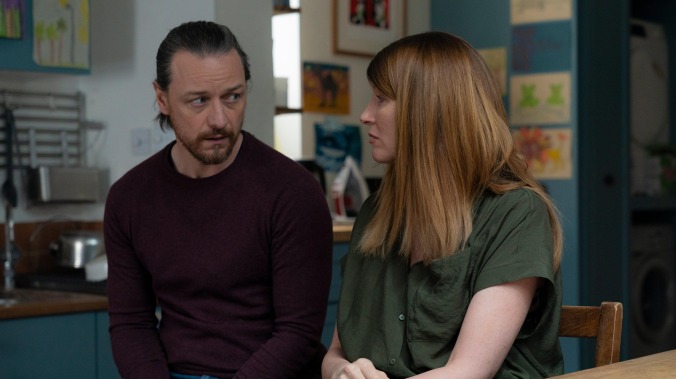James McAvoy and Sharon Horgan are stuck Together in another damn COVID movie
Both stars excel at acting out feuding-couple material that might have played better on stage

Back in January, before most audiences would have even had their vaccines, Doug Liman’s Locked Down combined domestic strife and a heist movie into an old-fashioned comedy of remarriage, set against a decidedly, sometimes uncomfortably up-to-the-minute backdrop: the COVID-19 pandemic, specifically the early weeks of lockdown in London. Nearly nine months later, the pandemic rages on, and another established director has concocted a not-quite-two-hander about a couple feuding their way through the forced intimacy of lockdown in the United Kingdom—but here, without the escape hatch of genre thrills. The unnamed, unmarried couple played by James McAvoy and Sharon Horgan, and observed by frequent awards-contender director Stephen Daldry, have only their fraught shared history to pore over with sharp-tongued precision. Which they do, in six extended scenes that move fluidly between monologue and duet, much of both addressed directly to the audience.
Sometimes the pair explains themselves in tandem, their seething, bone-deep disgust with each other still oddly suggesting besotted lovers who finish each other’s sentences. Sometimes, one or the other—more often McAvoy—will take the reins alone. Less often, they’ll talk to each other, rather than the camera. In every configuration, there are grievances. His working-class roots have made him unbearably pompous about his business success, and unempathetic to those he perceives as having worked less hard than he has. Her desire to express moral correctness belies her life of privilege. They can’t even agree on whether to call their pre-teen son Arthur or Artie (he’s played by Samuel Logan, in any event). They do, however, share a mutual facility with cruel assessments and visceral descriptions of each other’s shortcomings.
In case it wasn’t clear from any of this description, screenwriter Dennis Kelly has experience as a playwright—and on stage, the toxic zingers McAvoy and Horgan fling about would probably get the big laughs largely absent from this film. Only in fits and starts does Together capture the electricity of live performance. Kelly and Daldry do find some unexpected rhythms within the space of their long takes built into even longer scenes. For as quickly as the movie dives into its sniping, the characters show themselves capable of grudgingly conceding each other’s few good points. In its earliest moments, Together feels as if it’s going to try to be as scabrous a work of coupled earth-scorching as Who’s Afraid Of Virginia Woolf? or The Lockhorns. Thankfully, it’s neither as exhausting as the former nor as unfunny as the latter. (In a refreshing rewrite of a musty bickering-couple gag, the male half of the couple quite likes his mother-in-law.)
McAvoy and Horgan are both quite good, and a pleasure to listen to, with their competing Scottish and Irish lilts. But ultimately, the more compelling duel here isn’t between them. Rather, it’s in the way the characters are forced to grapple with the pandemic, a guest that refuses to leave and alters their lives even as they stay inside and do very little. Between its big scenes, the film moves ahead by a few weeks at a time, then months, then weeks again. It may be the first mainstream film to repeatedly mention the recent vaccines, and there’s a strange thrill in wondering how close the story will get to the current moment—if it will actually, somehow, catch up to whatever IRL mood swing its audience happens to experience the day they watch it.
Of course, a movie cannot actually do this in the best of circumstances, never mind during a global crisis that pushes inexorably forward every day. (U.K. audiences did get a better shot at immediate verisimilitude; Together aired on BBC Two back in June, just a month or so after the movie’s final scene takes place.) The best/worst it can offer is capturing some moments of devastation—and the way those moments uncomfortably wedge themselves into the everyday business of cooking dinner or squabbling about politics.
When Together confronts the helpless living nightmare of a pandemic’s ongoing irresolution, it taps into a scary rawness. As it sorts through the couple’s relationship, the film resorts to affection (like how the camera will capture little Arthur in silent listening mode, but never gives him any proper lines) before eventually opting to brazenly knock off Phantom Thread. One of Kelly’s central anecdotes so thoroughly bites from such a memorable recent movie that the decision to follow it through becomes distractingly perverse, making it difficult to get caught up in the emotional realism of the performances. The film does commit, though, to one principle of pandemic movie-watching: There are few films so good as to be immune to nagging off-screen distractions.